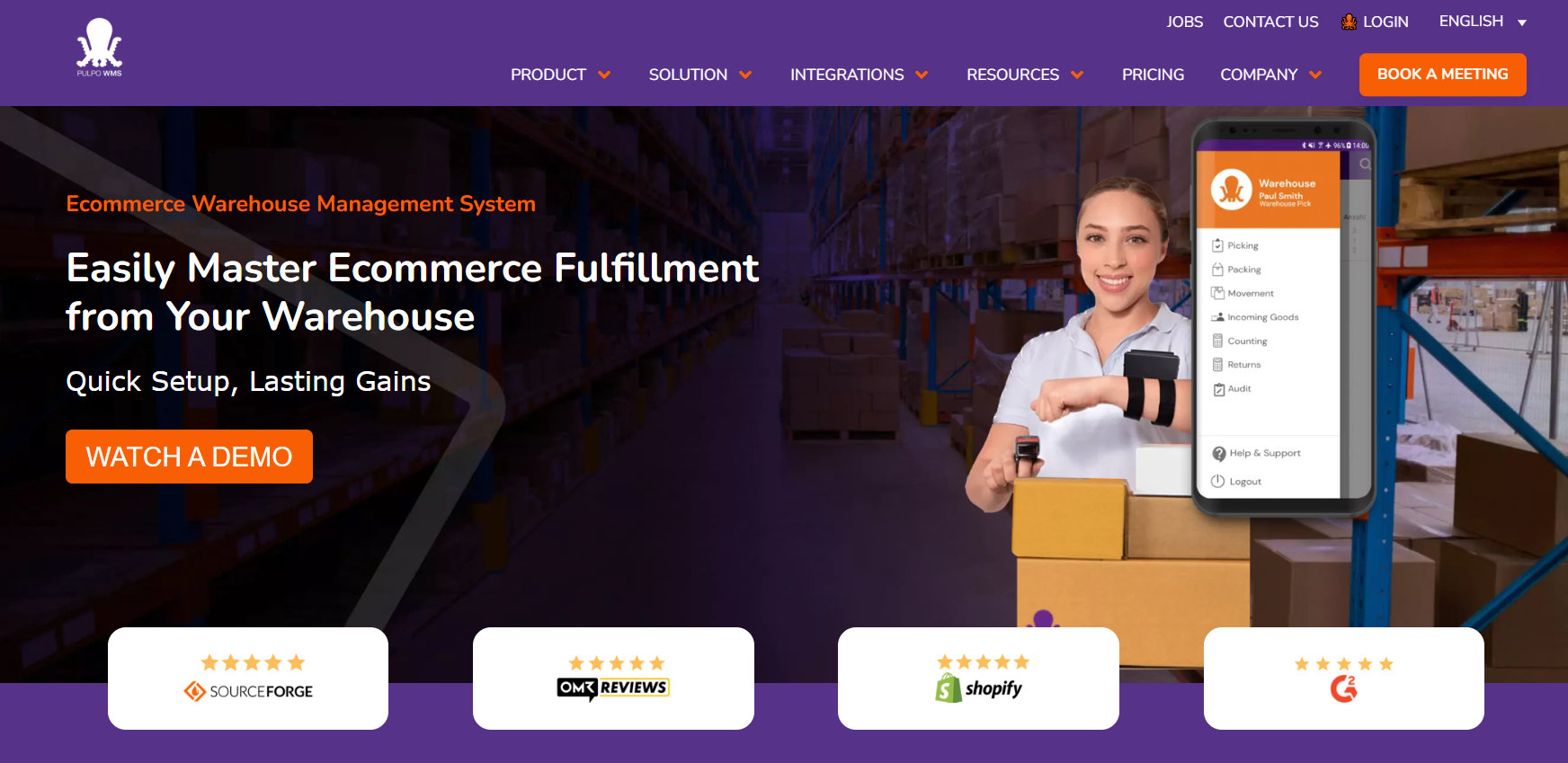In the world of ecommerce, where speed, accuracy, and efficiency are paramount, having the right tools to manage your warehouse operations is critical. An Ecommerce Warehouse Management System (WMS) is one of the most powerful solutions for optimizing order fulfillment, improving inventory management, and ensuring seamless logistics. Choosing the right ecommerce WMS can be a daunting task due to the wide range of available options, features, and varying business requirements.
This guide will walk you through everything you need to know about selecting the best ecommerce warehouse management system for your ecommerce business, covering essential features, integration options, pricing, scalability, and other key factors that will impact your decision.
Why Your Ecommerce Business Needs a Warehouse Management System
Before delving into the process of choosing a WMS, it’s important to understand why an ecommerce business needs one in the first place.
Improved Order Accuracy and Speed
In ecommerce, order accuracy and fulfillment speed can make or break customer relationships. An effective WMS automates the entire fulfillment process, from picking and packing to shipping, helping reduce errors, improve speed, and ultimately deliver a better customer experience.
Real-Time Inventory Visibility
Real-time inventory tracking ensures that stock levels are always up to date, preventing overselling or stockouts. This visibility is critical for ecommerce businesses, especially when dealing with multiple sales channels or during peak seasons when order volumes surge.
Increased Operational Efficiency
By optimizing workflows, automating manual tasks, and improving warehouse layout management, a WMS helps to reduce labor costs and improve productivity. This leads to a leaner, more efficient operation that can handle larger order volumes without increasing overhead.
Scalability
As your ecommerce business grows, so too will your need for more complex and capable warehouse management. A scalable WMS allows you to easily manage increased order volumes, additional warehouses, and new sales channels as your business expands.
Key Features to Look for in an Ecommerce WMS
Not all WMS solutions are created equal, and the best one for your business depends on your specific needs. Here are some key features to consider when choosing an ecommerce WMS.
Real-Time Inventory Management
One of the core functions of any WMS is to track inventory in real-time across multiple locations. A good WMS should offer complete visibility into stock levels, allowing you to track goods as they move through the supply chain and alerting you when stock reaches reorder points.
Real-time inventory management helps prevent stockouts and overstock situations, both of which can be costly. It also ensures that your customers always have accurate product availability information.
Order Fulfillment Automation
The efficiency of your order fulfillment process is crucial to the success of your ecommerce business. Look for a WMS that offers automated picking, packing, and shipping processes. Advanced features like wave picking, batch picking, and zone picking can significantly reduce the time it takes to fulfill orders, especially when dealing with high volumes.
Automating the fulfillment process helps ensure that orders are processed accurately and shipped promptly, leading to higher customer satisfaction and fewer returns due to errors.
Shipping and Carrier Integration
Shipping is a major cost and operational aspect of ecommerce. A WMS should integrate with multiple shipping carriers to offer rate comparison, generate labels, and track shipments in real-time. This allows you to choose the most cost-effective shipping options for each order and provide customers with accurate shipping information.
Look for a WMS that integrates with popular carriers like UPS, FedEx, DHL, and USPS, and allows for automatic shipping label generation and tracking updates.
Multi-Channel Integration
Most ecommerce businesses sell across multiple platforms, such as their own website, Amazon, eBay, and other marketplaces. A WMS should seamlessly integrate with these sales channels, syncing order data and inventory levels in real-time.
This multi-channel integration helps eliminate manual data entry errors, provides a unified view of all orders, and ensures that your inventory is accurately represented across all platforms, preventing overselling and stock discrepancies.
Returns Management
Handling returns is an inevitable part of running an ecommerce business. A good WMS should simplify the returns process by allowing for easy identification, sorting, and restocking of returned products. Automating returns workflows can speed up the process and ensure that your warehouse staff is not bogged down by manual tasks, while also providing customers with a seamless return experience.
Demand Forecasting and Reporting
An advanced WMS should offer robust reporting and analytics tools that provide insights into your inventory turnover, order fulfillment times, and employee productivity. Demand forecasting tools, based on historical data, help you predict future sales and optimize stock levels, ensuring you have enough inventory to meet demand without overstocking.
Mobile Accessibility
Many modern WMS solutions offer mobile functionality that allows warehouse staff to use handheld devices or tablets for tasks like picking, receiving, and restocking inventory. Mobile access enhances efficiency by enabling employees to perform tasks in real-time without having to rely on desktop computers, improving speed and accuracy.
Key Factors to Consider When Choosing an Ecommerce WMS
With so many WMS options available, it’s important to evaluate which system will meet your business’s unique needs. Here are key factors to consider:
Scalability
Your ecommerce business is likely to grow, and you need a WMS that can scale with you. Whether you’re adding more products, expanding into new markets, or increasing the number of orders you process, your WMS should be able to accommodate these changes without requiring a complete overhaul.
Ease of Integration
One of the most important aspects of a WMS is its ability to integrate seamlessly with your existing systems, including ecommerce platforms (e.g., Shopify, WooCommerce, Magento), Enterprise Resource Planning (ERP) software, accounting tools, and customer relationship management (CRM) systems. Integration minimizes manual data entry, reduces errors, and ensures real-time synchronization of order and inventory data.
Cloud-Based vs. On-Premises Solutions
When choosing a WMS, you’ll need to decide whether you want a cloud-based or on-premises solution. Cloud-based WMS systems offer more flexibility, as they can be accessed from anywhere and typically involve lower upfront costs. They also tend to be easier to update and maintain, as the software provider handles all system updates and security patches.
On-premises solutions, on the other hand, offer more control but often come with higher initial costs and ongoing maintenance responsibilities. These systems are typically best suited for larger businesses with specific IT infrastructure requirements.
User-Friendliness
A WMS should be easy for your staff to use. Complicated systems that require extensive training can slow down warehouse operations and lead to errors. A user-friendly interface with intuitive navigation is crucial for ensuring that your warehouse staff can efficiently use the system, even during busy periods.
Customization Options
Every ecommerce business has unique needs, and a one-size-fits-all approach may not work for you. Look for a WMS that offers customization options, allowing you to tailor workflows, reports, and settings to your specific warehouse operations.
Customer Support and Training
Implementing a WMS can be a complex process, and even after implementation, your team will need ongoing support and training. Choose a vendor that offers comprehensive customer support, including 24/7 assistance, online resources, and hands-on training. This support is especially critical during the onboarding process when your team is getting accustomed to the new system.
Total Cost of Ownership (TCO)
While it’s tempting to focus solely on upfront costs, it’s important to consider the total cost of ownership (TCO) when choosing a WMS. This includes ongoing maintenance, software upgrades, and potential customization fees. Some WMS solutions charge per user or per transaction, while others may have fixed pricing models. Make sure you fully understand the pricing structure and factor in any additional costs that could affect your long-term budget.
How to Evaluate Ecommerce WMS Providers
Once you’ve identified the key features and factors that are important to your business, it’s time to start evaluating WMS providers. Here’s a step-by-step process to help you make an informed decision:
Assess Your Current Operations
Before you begin evaluating WMS providers, take a close look at your current warehouse operations. Identify bottlenecks, inefficiencies, and pain points in your fulfillment process. This assessment will help you determine which WMS features are most critical for your business.
Request Demos and Trials
Once you’ve narrowed down your list of potential WMS providers, request demos and trials to see how the system works in a real-world setting. Make sure to test key features like inventory management, order fulfillment, and reporting. Involve your warehouse staff in the demo process to get their feedback on usability and functionality.
Check for Industry-Specific Solutions
Some WMS solutions are designed for specific industries, such as ecommerce, manufacturing, or distribution. Choose a WMS that is tailored to ecommerce operations, as these solutions are more likely to have the features you need to optimize order fulfillment, manage returns, and integrate with multiple sales channels.
Read Customer Reviews and Case Studies
Customer reviews and case studies can provide valuable insights into how a WMS performs in real-world applications. Look for reviews from ecommerce businesses that are similar in size and scope to yours. Case studies can also show how the system helped other companies overcome challenges and achieve specific goals.
Evaluate the Vendor’s Reputation and Longevity
Finally, consider the vendor’s reputation and longevity in the industry. A WMS is a significant investment, and you want to choose a provider that has a proven track record of success and long-term viability. Look for vendors that have experience working with ecommerce businesses and a strong reputation for customer support and innovation.
Conclusion
Choosing the right ecommerce warehouse management system is crucial for optimizing your warehouse operations, improving order accuracy, and ensuring seamless integration with your existing systems. By focusing on key features like real-time inventory management, order fulfillment automation, and shipping integration, and by carefully evaluating your needs, you can find a WMS that will help your business grow and scale efficiently.
Take the time to assess your current operations, request demos, and read reviews to ensure that you’re selecting a WMS that fits your specific needs. With the right system in place, you can streamline your warehouse processes, reduce costs, and improve your overall customer experience.





